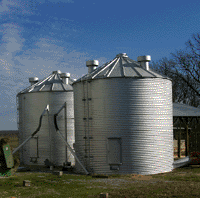Remember the Term S.AM. When Dealing With Grain Storage Systems
Remember the Term S.AM. When Dealing With Grain Storage Systems

In spite of some late summer drought problems, many Kentucky storage bins are filled to capacity. Like any perishable commodity, grain crops need periodic care and maintenance.
How producers go about that grain storage process will affect the quality of the crop and the health and safety of the people working in and around the storage bins.
"Just remember the term SAM when dealing with grain storage," said Sam McNeill, Extension Agriculture Engineer in the University of Kentucky College of Agriculture based at the Research and Education Center in Princeton, KY.
The term refers to the three key elements in stored grain management that include Safety, Aeration and Monitoring.
"Safety is the foremost issue," said McNeill. "No grain crop is more valuable than a human life and a grain bin can be a dangerous place to work. Every once in a while someone gets caught in flowing grain and gets pulled below the surface with deadly consequences.
All workers need basic training on how to work in and around grain bins and these storage facilities should be regarded as a "keep out" zone for children.
" You should never enter a bin while unloading grain," added McNeill. "If a bin must be entered, the switch on the unloading auger needs to be locked out."
Workers always should be attached to a safety line with one or two workers stationed outside the bin to pull the individual to safety in the event of an emergency. All concerned need to understand entrapment and suffocation hazards.
"Stored grain is susceptible to insect and mold damage if it isn't properly aerated," said McNeill. "The key here is to keep the temperature of the grain in the center of the bin to within 10 degrees of the average grain temperature near the bin wall."
Running bin fans at least once per month should help moderate the temperature fluctuations during typical Kentucky winters. If producers can keep the temperatures inside the bins within the 10 to 15 degrees of the monthly average temperatures of a region, they can keep moisture problems to a minimum and reduce mold and insect activity.
"Once you get temperatures stabilized in the bin, it is wise to seal the fan with plastic or a tarp to block the air flow so that you don't have drafts moving through the grain through the fan opening," added McNeill.
Monitoring the grain every two to four weeks also is a good policy. Producers may want to step up their monitoring as they get further into spring.
"If you inspect every couple of weeks, you can stay ahead of anything that may develop," said McNeill. "If you inspect once a month, you might lose some grain in suspect areas of the bin."
Look for signs of spoilage under fill spouts, roof vents and along the wall. It is recommended to take several samples six to 12 inches below the grain surface to check for insect or mold activity. Use temperature cables if available.
Keeping the bin and surrounding area clean also can help maintain grain quality. Remove spilled grain from the ground around bins and unloading augers and mow all weeds with 10 feet of the storage bin.
"This keeps your bins from attracting additional insects and rodents," said McNeil. "You may want to consider fumigation if insects are found in stored grain next summer."
A more detailed review of the all elements of the SAM system, including tables on recommended temperature and moisture levels specifically geared for Kentucky, are listed in bulletin AEN-45 which is available from your local county Cooperative Extension Service office.